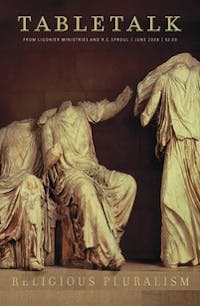
Request your free, three-month trial to Tabletalk magazine. You’ll receive the print issue monthly and gain immediate digital access to decades of archives. This trial is risk-free. No credit card required.
Try Tabletalk NowAlready receive Tabletalk magazine every month?
Verify your email address to gain unlimited access.
Today’s postmodernists use cultural pluralism as a pretext for relativism, as if the existence of many cultures implied the existence of many truths. Many Americans embrace multiculturalism as if they had no culture of their own. In religion, pluralism has given rise to a new polytheism. And yet, there is a kind of pluralism that is good, necessary, and biblical.
The apostle Paul speaks of a radical pluralism that nevertheless constitutes a unity: “For just as the body is one and has many members, and all the members of the body, though many, are one body, so it is with Christ. For in one Spirit we were all baptized into one body — Jews or Greeks, slaves or free — and all were made to drink of one Spirit. For the body does not consist of one member but of many. If the foot should say, ‘Because I am not a hand, I do not belong to the body,’ that would not make it any less a part of the body. And if the ear should say, ‘Because I am not an eye, I do not belong to the body,’ that would not make it any less a part of the body. If the whole body were an eye, where would be the sense of hearing? If the whole body were an ear, where would be the sense of smell? But as it is, God arranged the members in the body, each one of them, as he chose. If all were a single member, where would the body be? As it is, there are many parts, yet one body…. If one member suffers, all suffer together; if one member is honored, all rejoice together. Now you are the body of Christ and individually members of it” (1 Cor. 12:12–20, 26–27).
The church consists of a multitude of distinct individuals, as different from each other as hands and ears and eyes. And, at the same time, for all of their differences, they are all unified in Christ.
We speak of the “members” of a congregation. That word originally meant “parts of the body.” By now, many of the rich metaphors of the English language have been reduced to just colorless words, so a “member” is just another name on the church roll. But the word goes right back to 1 Corinthians 12 — the member listed on the church roll must be a foot, a hand, an ear, an eye, or some other organ of the body.
The point seems to be that God treasures unique individuals, with different cultures (Jews, Greeks), social positions (slave, free), genders (male, female), gifts, modes of service, and personalities. He has called all of these different kinds of people to Himself, and, through faith has united them to Himself and to each other. They all have the same faith in Christ, who redeemed them and who incorporates them into His body, of which He is the head.
Some congregations encourage conformity, pressuring its people to not be “members” but to be just like each other. In fact, the church growth movement encourages homogeneity. Its methodology came from the missionaries who found that they could make the most progress by appealing to one cultural group at a time. Now, even in America, megachurches usually appeal to the same range of middle class suburbanites. Some have separate services for each generation. Twenty-somethings worship just with each other, as do baby-boomers, old-timers, young marrieds, and little kids. This is a far cry from the unity-of-diversity taught in 1 Corinthians 12.
The body of Christ, of course, goes far beyond individual congregations. Its “members” extending back through history include warriors, peacemakers, rulers, artists, a few intellectuals, lots of slaves, peasants, and ordinary folks in all their various backgrounds, experiences, and characteristics.
This principle inheres throughout the creation. In the body, of course, which consists of millions of self-contained cells that cohere into “members” to form a single organism. In nature, each organism contributes to the others in a complex ecological balance.
Societies also work like that. The economy depends on a division of labor with a variety of different producers and consumers. In government, an emphasis on unity alone produces totalitarianism; an emphasis on pluralism alone produces anarchy. Successful governments of free societies must attain a delicate balance of unity and diversity. This is expressed in the motto of the United States of America: e pluribus unum. Out of many, one.
The balance of unity and diversity is also an aesthetic principle. Modern abstract art sometimes might feature a plain black canvas — which has unity, but no diversity — or random splotches of paint — which has diversity but no unity. Neither have much to them aesthetically. But a great work of art — the Sistine chapel, a Hudson River School landscape — has incredible variety of detail while still coming together into an overall unity.
Looming behind all of these cases is the source of creation, the church, and all that is good, the Triune God. He consists of three distinct Persons — the Father, the Son, and the Holy Spirit — who together constitute an absolute unity.
To deny the plurality of the persons of the Trinity is a heresy, as is denying their unity. Confusions in art, politics, environmental management, and relationships in the church can entail heresies of their own.
